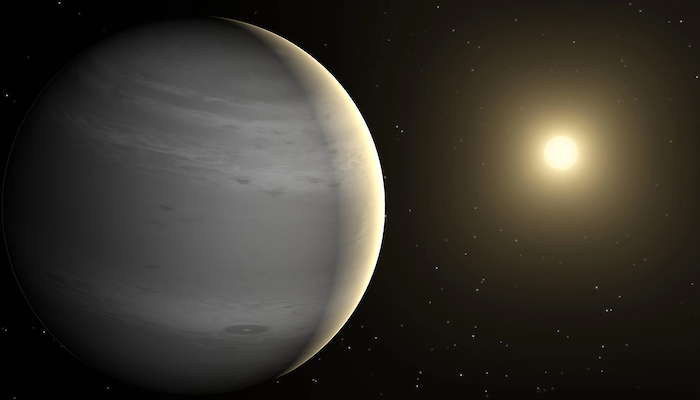This year’s discovery of a strangely-behaved exoplanet about 1100 light years from Earth, , has helped an international astronomy team better understand the formation of a class of planets called ‘hot Jupiters’ – gas giant planets orbiting close to their star.

Huge and hot: This artists impression of a ‘hot Jupiter’ shows a category of planet outside our solar system, similar in size to Jupiter but orbiting very close to their host stars. Credit: Noir Lab
‘Exoplanet’ is the term for any planet outside our solar system. This new discovery is a gas giant about five times the size of Jupiter which was spotted by NASA’s (TESS), a space telescope gathering information about planets outside our solar system.
And in a scenario reminiscent of the Netflix sci-fi hit , the exoplanet’s crazy orbit shows it is also under the influence of the other star in its binary star system.
Australian astronomers
Macquarie University astronomers Dr Jaime A Alvarado-Montes and Associate Professor Christian Schwab were the only Australian astronomers on a team of more than 60 researchers from eight countries and more than 35 institutions to report on the TESS data, recently .
Associate Professor Schwab designed the optics for NASA’s Extreme Precision Radial Velocity Spectrograph, NEID, a crucial part of the ground-based equipment used to home in on the target planet after TESS spotted an indication a planet was orbiting the star TIC 241249530.
“Dr Arvind Gupta from NOIRLab in Tucson, Arizona, led a team that used the NEID Spectrometer, installed at the 3.5m WIYN telescope, to make more than 50 high- precision observations spanning 2.5 years,” Associate Professor Schwab says.
“These observations measured the planet’s mass – and also revealed its extreme orbit.”
Once the orbital parameters were precisely known, Dr Alvarado-Montes got to work on computer models simulating how the planet’s orbit has changed over time.
Under the influence
The researcher’s models suggest this planet initially formed as a cold Jupiter far from its star, but the influence of gravity from its own star, and the star’s pair, caused it to gradually migrate inward, in what is likely a stage in the process of it becoming a hot Jupiter.
“Several billion years ago, the planet formed as a cold Jupiter, far from its star, in a region cold enough to condense and take shape,” Dr Alvarado-Montes says.
“Then gravitational forces from the second, binary star in the system caused the planet’s orbit to gradually stretch and grow eccentric, and it began to swing ever closer to the star.”
The team have dubbed the newly discovered planet a “hot Jupiter progenitor,” and have modelled the exoplanet’s slow evolution into its current, highly eccentric, 166-day orbit.
From very close to its star – 10 times closer than Mercury is to the Sun – the planet moves in an egg-shaped path, swinging farther out to about as far as Earth is from the Sun.
In the Nature paper, the authors write: “Few exoplanets have orbits as extreme as this; this orbit is more eccentric than that of any other transiting exoplanet.”
Impossible planets: why hot Jupiters shouldn’t exist
Hot Jupiters challenge our understanding of planetary formation and evolution.

“Should not exist”: Astrophysicists say hot Jupiters challenge our understanding of planetary formation and evolution. Artists impression – Credit: NASA
“In our own solar system, Mercury is a tiny, rocky marble orbiting the Sun every 88 days, while gas giant Jupiter gets around in 12 years,” says Dr Alvarado-Montes.
“By contrast ‘hot Jupiters’ are gas planets like Jupiter, or even bigger, but so close to their star their orbits are less than 10 days.
“Theoretically, these planets should only be able to form very far from a star, because the gas making up more than 90 per cent of their mass should not be able to accumulate or survive close to the star’s intense heat and radiation,” Dr Alvarado-Montes says.
Typically, as planets form close to young stars and grow from tiny clouds of dust and gas, the star’s heat causes gas particles to evaporate or transform, so only rock and metal remains.
No landing on Jupiter
“When we look at Jupiter, we actually see the top of its thick atmosphere, not a solid surface,” says Dr Alvarado-Montes.
“Any spacecraft trying to ‘land’ would have to travel for days through dense layers of gas, facing pressures that would destroy our current technology.”
NASA’s Galileo probe, which gathered data about Jupiter in 1995, transmitted for an hour and reached 160 kilometres into the atmosphere before mounting pressure crushed it.
“Although Jupiter could fit around 1000 Earths in its atmosphere, it has a tiny core the size of Earth buried under 70,000 kilometres of gas, creating pressures millions of times greater than Earth’s surface,” Dr Alvarado-Montes says.
Extreme planet
The newly-discovered exoplanet TIC 241249530 b sheds light on the formation of hot Jupiters – and provides a real-world example of a mathematical puzzle, the 3-Body problem, popularised by Liu Cixin’s Hugo Award-winning novel and accompanying hit Netflix series.
On fictional planet Trisolaris, gravitational forces from three stars cause extreme and unpredictable seasons that intermittently destroy the local civilisation.
“If anything, conditions on the newly-discovered planet make the world of Liu Cixin’s novel, and even our own planet Jupiter, look relatively benign,” says Associate Professor Schwab.
“The planet TIC 241249530 b would experience radical temperature changes in the six months it takes to orbit the star,” Associate Professor Schwab says.
When closest to the star, the planet’s atmosphere would expand and partially evaporate from the intense heat and radiation, and the side of the planet facing the star could be hot enough to melt rock or vaporise metals.
As the planet orbits away from the star, it would cool dramatically as the constant heating and cooling cycle creates powerful storm systems far more extreme even than that of Jupiter.
The researchers have modelled the history and likely progression of TIC 241249530 b – and predict a happy ending.
“Over the next million years, this planet is likely to settle into a stable, close orbit around its primary star and fully transform into a hot Jupiter,” says Dr Alvarado-Montes.
“This shows that patterns and predictability emerge when we view the progress of celestial bodies over astronomical timescales.”

Exoplanet specialist: astronomer Dr Jaime A Alvarado-Montes joined a 60-strong international team to analyse data from a newly-discovered ‘Hot Jupiter’ planet with a crazy orbit, 1100 light years from Earth.
and are from the .







